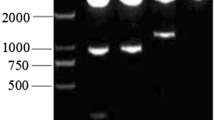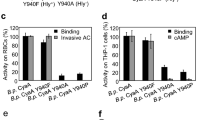Abstract
Clostridium perfringens alpha toxin is known to possess various biological activities (hemolysis, lethality, necrosis) and, in addition, phospholipase C (PLC) activity (4). It has been reported that these biological activities of the toxin are due to the PLC activity (4). We have reported that the toxin-induced contraction of isolated rat ileum or aorta and the toxin-induced hemolysis of rabbit erythrocytes are closely related to phospholipid metabolism stimulated by the toxin (1, 6, 7, 8). However, little is known about the relationship between these biological activities and PLC activity. The gene encoding alpha toxin has been isolated from chromosome of the organism and characterized (9). The genes encoding PLC’s of C. bifermentans and Bacillus cereus also have been isolated. From these findings, the deduced amino acid sequences of alpha toxin and these enzymes were found to have significant homology up to approximately 250 residues from N-terminus. Hough et al. have reported the three-dimensional structure of the B. cereus PLC, which binds three Zn2+(2). Little and Otnass reported that the B. cereus PLC has two tightly bound zinc ions and one loosely bound zinc ion (3). It is reported that these ions are coordinated to fixed histidine residues in the enzyme (2). Alpha toxin is known to be one of zinc-enzymes. Vallee and Auld (10) reported the possibility that the ligand spacers and vicinal amino acids of the B. cereus PLC resemble the likely location of the metal binding sites in the toxin (2). Recently, it has been reported that histidine residues in zinc-proteins such proteases and botulinum toxin are ligands to Zn2+. Therefore, to clarify the mode-of-action of alpha toxin, we replaced all of histidine residues in the toxin to glycine by site-directed mutagenesis, and then investigated the relationship between histidine residues and Zn2+ contents or the biological and PLC activities.
Access this chapter
Tax calculation will be finalised at checkout
Purchases are for personal use only
Preview
Unable to display preview. Download preview PDF.
Similar content being viewed by others
References
Fujii, Y, and Sakurai, J. 1989. Br. J. Pharmacol. 97: 119–124.
Hough, E., Hansen, L.K., Birknes, B., Jynge, K., Hansen, S., Hordvik, A., Little, C, Dodson, E., and Derewenda, Z. 1989. Nature 338: 357–360.
Little, C, and Otnass, A. B. 1975. Biochim. Biophys. Acta 391: 326–333.
McDonel, J. L. 1986. In Dorner, F., and Drews, J. (eds.), p 477-517 Pharmacology of bacterial toxins, Pergamon Press, Oxford.
Nagahama, M., Iida, H., Nishioka, E., Okamoto, K., and Sakurai, J. 1994. FEMS Microbiol. Lett. 120: 297–302.
Sakurai, J., Fujii, Y., and Shirotani, M. 1990. Toxicon 28: 411–418.
Sakurai, J., Ochi, S., and Tanaka, H. 1993. Infect. Immun. 61: 3711–3718.
Sakurai, J., Ochi, S., and Tanaka, H. 1994. Infect. Immun. 62: 717–721.
Titball, R.W., Hunter, S.E.C., Martin, K.L., Morris, B.C., Shuttleworth, A.D., Rubidge, T., Anderson, D.W., and Kelly, D.C. 1989. Infect. Immun. 57: 367–376.
Vallee, B.L., and Auld, D.S. 1993. Biochemistry. 32: 6493–6500.
Author information
Authors and Affiliations
Editor information
Editors and Affiliations
Rights and permissions
Copyright information
© 1996 Plenum Press, New York
About this chapter
Cite this chapter
Nagahama, M., Ochi, S., Kobayashi, K., Sakurai, J. (1996). The Relationship between Histidine Redidues and Various Biological Activities of Clostridium perfringens Alpha Toxin. In: Singh, B.R., Tu, A.T. (eds) Natural Toxins 2. Advances in Experimental Medicine and Biology, vol 391. Springer, Boston, MA. https://doi.org/10.1007/978-1-4613-0361-9_19
Download citation
DOI: https://doi.org/10.1007/978-1-4613-0361-9_19
Publisher Name: Springer, Boston, MA
Print ISBN: 978-1-4613-8016-0
Online ISBN: 978-1-4613-0361-9
eBook Packages: Springer Book Archive




